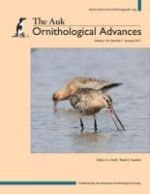Seabirds inhabiting large, multispecies colonies face intraspecific and interspecific competition for prey and this often results in foraging strategies that partition resources. Here, we identified mechanisms that facilitate partitioning of resources between 2 congeneric tropical seabirds, Great Frigatebirds (Fregata minor) and Lesser Frigatebirds (F. ariel), for which traditional research methods have documented high levels of resource overlap. Stable isotope analysis (SIA) indicated that throughout the breeding cycle, male and female Great Frigatebirds consumed prey with higher δ15N compared to male Lesser Frigatebirds. This trend was not significant when comparing δ15N values of male and female Great Frigatebirds to female Lesser Frigatebirds. During the breeding period, GPS tracking and SIA indicated considerable spatial overlap among species and sexes. This contrasted with SIA of samples that provide insight into nonbreeding resource acquisition because these indicated that male Great Frigatebirds and male Lesser Frigatebirds had lower δ13C values than females of each species, signifying greater use of offshore foraging grounds by males of both species. Together these results suggest that body size differences influence trophic position of the prey consumed. Furthermore, central-place foraging constraints, and spatially unpredictable resource distribution, limit potential for spatial differences in foraging strategies when breeding. By contrast, spatial distribution of foraging differs during the nonbreeding period as the requirement for central-place foraging is lifted.
How to translate text using browser tools
7 December 2016
Resource partitioning between species and sexes in Great Frigatebirds and Lesser Frigatebirds
Rowan Mott,
Ashley Herrod,
Rohan H. Clarke

The Auk
Vol. 134 • No. 1
January 2017
Vol. 134 • No. 1
January 2017
diet
feeding zones
foraging ecology
kernel analysis
marine predators
niche differentiation
prey specificity




